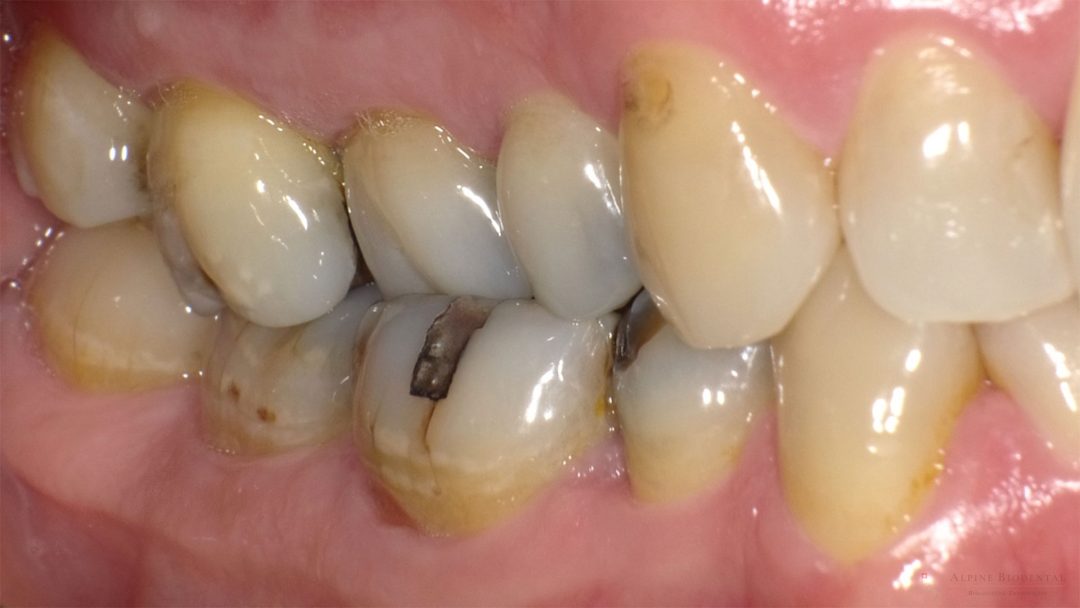Amalgam Filling

Amalgam fillings are dental fillings made of a mercury alloy, which were once very popular and frequently inserted into teeth. The silvery fillings are durable, inexpensive and easy to work with, which is why they enjoyed great popularity among dentists.
Amalgam fillings are now highly controversial among the general public and dentists because it has long been proven that the toxic effect of mercury can lead to health problems.
Amalgam is often incorrectly referred to as amalgam or amalgam fillings.
What is Amalgam?
Amalgam is a mercury alloy, i.e. a composition of mercury with other metals.
Dental amalgam consists of 50% mercury, with the other half being made up of metals such as copper, silver, tin and zinc.
The mercury compounds in particular, which can dissolve from the amalgam dental filling, are suspected of causing health problems.
Capsules in which liquid mercury and the other metals (powder) are spatially separated from each other are used to produce amalgam in the dental practice. The separation is broken and an amalgam rotor is used to mix the components homogeneously. The resulting paste is stuffed into the tooth defect and molded. After approx. 24 hours, the material is completely hardened and remains in the oral cavity for many years as an amalgam filling.
Use of Dental Amalgams
More and more large companies in the dental market are gradually withdrawing from the amalgam business. In 2022, for example, Dentsply Sirona and Kerr said goodbye to amalgam sales.
The Minamata Agreement, which was signed by 140 countries, came into force in 2017. It regulates the gradual phasing out of dental amalgam. The current goal is to phase it out completely by 2030. The EU Commission has decided to completely ban the production and use of dental amalgam in the EU by 2025.
Some countries such as Sweden, Norway and Denmark have already banned dental amalgam completely.
The use of amalgam in dental practices is steadily decreasing year on year.
Switzerland
The Swiss Chemical Risk Reduction Ordinance takes the following position on dental amalgams: “The use of dental amalgam is prohibited if another filling material can be preferred for medical reasons.
In Swiss dental practices, the use of dental amalgams is less than 1%. Consequently, the average Swiss dentist opts for an amalgam filling in less than 10 out of 1000 cases.
Germany
The use of dental amalgam is also slowly decreasing in Germany. According to the European Center for Environmental Medicine, use is below 10%.
The reason for the higher use than in Switzerland is that amalgam fillings are fully covered by health insurance. If the patient wants a tooth-colored composite filling, they usually have to pay the extra cost themselves. As many patients are not prepared to bear the additional costs, the decision is made in favor of amalgam.
Mercury and Amalgam Poisoning
Amalgam consists of 50% mercury, a toxic heavy metal with the highest toxicity of all non-radioactive elements.
Amalgam poisoning can be influenced by various factors.
- The ability to detoxify. Some patients are able to detoxify quickly and effectively, while others have more difficulty detoxifying. The ability to detoxify is mainly genetically determined.
- The number of amalgam fillings in the mouth. The more amalgam fillings there are, the higher the mercury exposure
- Protective measures when removing amalgam fillings.
- Other metals in the oral cavity. If other alloys are present in the mouth, e.g. gold or titanium, a galvanic element and thus a battery effect occurs. This increases the release of metallic ions into the saliva.
- Age of the fillings. The older the amalgam filling, the higher the release of mercury.
- Presence of amalgam residues in the jaw.
Pathways of Mercury Release from Amalgam
Mercury enters the body from amalgam in different ways:
1. Vaporization
The amalgam fillings are heated by warm drinks and food and begin to evaporate. This was determined and documented by illuminating the amalgam with UV light. As mercury has the unmistakable property of absorbing the wavelength of 254 nm, a vaporizing shadow could be seen emanating from the amalgam filling. With increasing heating, the release of the mercury molecules increases.


When mercury is released by vaporization, it is mainly absorbed into the lungs by inhalation.
2. Abrasion
Any kind of friction causes fine amalgam particles to detach from the filling. The greater the friction, the greater the abrasion.
An example: If you polish over an amalgam filling with a rubber polishing cup and white toothpaste, it turns gray. The particles are clearly visible by the color change. This should always be taken into account during a professional tooth cleaning.
Fine particles are also released into the oral cavity when eating, brushing and grinding the teeth and preferentially enter the gastrointestinal tract.
An extreme form of abrasion occurs when amalgam is removed without protection. The patient’s exposure to mercury can be high and have health consequences.
3. Corrosion
Saliva is a saline solution and causes corrosion (rusting) of metal alloys. Components of the amalgam, including mercury, are released into the saliva in ionic form. It is absorbed via the oral mucosa and the gastrointestinal tract.
If other metals are also present in the oral cavity, e.g. titanium or gold, the corrosion is intensified and a so-called galvanic element is formed, as in a battery. As a result, the alloys connected via the saliva release more ions and the load increases again.
Dr. med. dent. Artur Hein
At Alpine BioDental, we are specialized in safe amalgam removal under protection and will be happy to help you. Just get in touch with us.

Possible Symptoms and Side Effects
Amalgam fillings can cause various symptoms and side effects in the long term due to the escaping mercury.
Such mercury exposure is sometimes referred to as amalgam poisoning and is based on a continuous accumulation of toxic metals in the body.
The older the amalgam filling, the rougher the surface and the more porosities and cracks are present, which increases the health impairment.
The symptoms and side effects caused by amalgam fillings are usually non-specific and can be distributed throughout the entire organism (generalized). Some examples are
Toxic and immunological Exposure to Mercury
As soon as mercury enters the body, it has different ways of causing damage. To simplify matters, the negative health effects can be divided into toxic and immunological exposure:
1. Toxic Exposure
Mercury is capable of blocking various proteins, enzymes and nucleotides and altering their function. As a result, physiological body functions are restricted and oxidative stress increases. In addition, the vital trace element zinc is very effectively displaced by mercury. The toxic effect can take place in every tissue and organ and massively impede bodily functions.
2. Immunological Exposure
Mercury is able to bind to various endogenous proteins and change their structure. This altered protein structure is recognized by the immune system as a foreign body, whereupon inflammatory (pro-inflammatory) immune messengers are produced. The immune system is activated and a generalized inflammation occurs.
In addition, the immune system attacks the body’s own mercury-altered proteins. The attack is carried out by autoantibodies, i.e. antibodies that are directed against the patient’s own body. This leads to the development of various autoimmune diseases.
What Amalgam Alternatives are there?
Nowadays, there are long-lasting and harmless alternatives to amalgam fillings.
If you don’t want to do without the high durability of amalgam fillings, you should opt for ceramic when choosing the material. Ceramic fillings or ceramic inlays show the best biological compatibility and can surpass amalgam fillings in terms of longevity.
When replacing large amalgam fillings, ceramic crowns are a good option to stabilize the severely damaged tooth.
Plastic fillings are another alternative to amalgam. These have a shorter lifespan than amalgam fillings and should be used for smaller tooth defects.
Frequently asked Questions about Amalgam Fillings
Patients who have had an amalgam filling in the past are often unsure what to do. In this section, we address common questions and try to answer them briefly but precisely.
Dental amalgam consists of mercury (50%) and other metals such as copper, silver, tin or zinc.
Old amalgam fillings often have cracks and a rough surface. The older they become, the more uneven and fissured the structure and the higher the release of metal ions.
An old amalgam filling can break or fall out completely.
If this happens to you, you should make an appointment with your dentist to have the unprotected tooth sealed again.
If you have swallowed the amalgam filling, there is no need to worry. The filling will come out on its own via the natural digestive system. Depending on your digestion, this can take between 24 hours and 7 days.
During this time, the toxicity is similar or slightly higher than with an amalgam filling in the mouth.
The ban on amalgam is underway and is expected to be completed in Europe by 2025 to 2030. In some European countries, such as Norway, Sweden and Denmark, amalgam has already been banned without restriction.
Amalgam has several advantages over plastic (composite). It has a long shelf life, is easy to use and is relatively insensitive to saliva or blood. This is why it is still used by some dentists for various indications.
The following tests can be used to determine amalgam poisoning:
- Saliva test
- Provocation test or mobilization test with DMPS
Blood tests, on the other hand, are not very meaningful in the case of amalgam poisoning because the mercury is absorbed from the blood into the body within a short time.
The metals in amalgam can have an effect on the immune system and cause sensitization or allergy. This reaction is usually a late-type allergy. Such an amalgam allergy can be diagnosed with a lymphocyte transformation test (LTT) blood test.
If you have a silver filling, it is most likely amalgam. You should contact your former dentist for precise information.
The body’s own bacteria convert the inorganic mercury into even more toxic organic methyl mercury. Various germs settle in the microscopic tubules of dead teeth, which further accelerate the methylation process.
Further information
Relevant information is listed below to provide you with more insight.